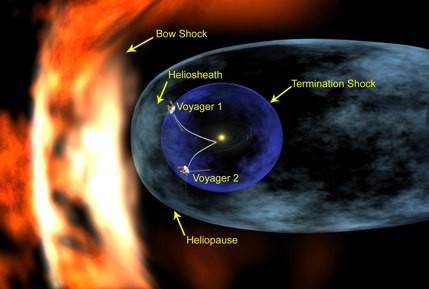In 1972 a young professor at the California Institute of Technology was asked to work part-time at NASA’s Jet Propulsion Laboratory as chief scientist for a new space mission, one that would probe the limits of the solar system and eventually enter interstellar space. Edward Stone accepted the assignment, and now, 33 years after the launch of the two Voyager spacecraft, he says the goal is in sight. He looks almost giddy as he talks about the implications of recent data received from Voyager 1. But first he must explain where the spacecraft is today.
“Voyager 1 is the most remote human-made object,” Stone says. “It’s now 115 astronomical units from Earth,” that is, 115 times farther than Earth is from the sun, or “a bit more than 10 billion miles [16 billion kilometers].” Voyager 2 has traveled somewhat slower and in a different direction and is now around 14 billion kilometers from Earth.
Both Voyagers are still within a “bubble” created by the solar wind, a stream of charged particles radiating outward from the sun at 1.6 million to 3.2 million kilometers per hour. This bubble, or heliosphere, exists, says Stone, because a magnetic field from outer space, likely resulting from the explosion of supernovae five million to 10 million years ago, is pushing back against the solar wind.
As the solar wind approaches the boundary with the interstellar wind, Stone says, it must go through a sonic shock, “just as the front of a supersonic aircraft.” Voyager 1 crossed that shock in December 2004, and ever since, “we have been in the heliosheath, which is the region where the solar wind has slowed down and is now turning to head back down the tail of the heliosphere.”
This is not a difficult concept to visualize, Stone says. “You can see it in your kitchen sink.” As water hits the sink, it splatters in a fast-moving radial pattern until it hits a thick ring, after which it turns and goes down the drain. “That’s exactly what’s happening in the solar wind.” It goes outward in all directions until it hits the shock, and then it turns.
In the past six months, Voyager 1 has signaled that the radial speed of the solar wind is zero, meaning that the spacecraft is approaching the final boundary of the solar system, the heliopause. Stone and his colleagues had not expected Voyager to reach this point for several more years, meaning that the boundary lies closer to the sun than they had thought. “So, our models need to be refined in order to account for these new observations, and that will tell us, once that’s done, how much farther Voyager has to go” before it enters interstellar space. Several presentations at the American Geophysical Union’s Fall Meeting in San Francisco this week deal with these issues, he said.
It may take a year or more of data analysis to confirm that Voyager 1 has actually crossed the heliopause, which is a flexible boundary, Stone says. There probably will not be a eureka moment when it happens. We will continue to receive data from the Voyagers until around 2020 or 2025, Stone says, well after they have left the solar system.
Leaving the solar system, he says, will be “a milestone in human activity.” Both Voyagers will likely outlive Earth, he notes. When, billions of years from now, the sun swells into a red giant, the Voyagers, albeit with their radioactive generators long exhausted and instruments frozen, will continue to wend their lonely ways through interstellar space and remain on course for the unknown, bearing a record disk and images of 20th-century Earth, music from many of its cultures, and greetings in dozens of its languages. They may be the only evidence the human race ever existed.










